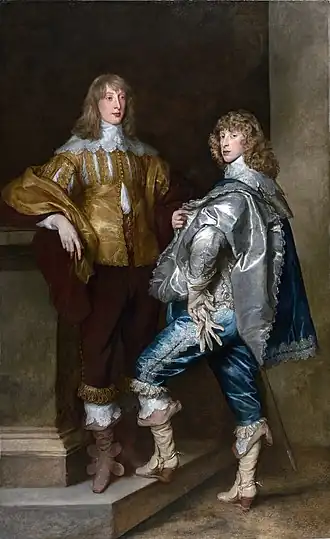
Esmé Stewart, 3rd Duke of Lennox (1579 – 30 July 1624), KG, 7th Seigneur d'Aubigny, lord of the Manor of Cobham, Kent, was a Scottish nobleman and through their paternal lines was a second cousin of King James VI of Scotland and I of England. He was a patron of the playwright Ben Jonson who lived in his household for five years.
Origins
He was the younger son of Esmé Stewart, 1st Duke of Lennox (1542–1583), a Frenchman of Scottish ancestry and a favourite of King James VI of Scotland (of whose father, Henry Stewart, Lord Darnley, he was a first cousin), by his wife Catherine de Balsac (died after 1630), a daughter of Guillaume de Balsac, Sieur d'Entragues, by his wife Louise d'Humières.
Career
At the death of his childless elder brother, Ludovic Stewart, 2nd Duke of Lennox, 1st Duke of Richmond (1574–1624), he inherited their paternal title of Duke of Lennox, the Dukedom of Richmond having become extinct. He was by then already Earl of March (in the peerage of England) (1619) and Baron Clifton of Leighton Bromswold (in the right of his wife).[3] He had become the 7th Seigneur d'Aubigny in France when his elder brother surrendered the title following their father's death.[4][5]
On 9 February 1608, he performed in the masque The Hue and Cry After Cupid at Whitehall Palace as a sign of the zodiac, to celebrate the wedding of John Ramsay, Viscount Haddington to Elizabeth Radclyffe .[6]
In 1624, the year of his death, he was invested as a Knight of the Garter.
Marriage and children
In 1609, he married Katherine Clifton, 2nd Baroness Clifton, by whom he had eleven children, third cousins of King Charles I, for whom many of them fought and died in the English Civil War:
Sons

- James Stewart, 4th Duke of Lennox, 1st Duke of Richmond (1612–1655), eldest son and heir. He resided at Cobham Hall in Kent (granted in 1606 to his uncle Ludovic Stewart, 2nd Duke of Lennox, 1st Duke of Richmond (1574–1624), by his second cousin King James VI & I) and served as Lord Warden of the Cinque Ports, based at Dover Castle in Kent;
- Henry Stewart, 8th Seigneur d'Aubigny (1616–1632). He studied in the City of Bourges (the capital of the former province of Berry, in which was situated Aubigny) and later at Paris, then visited Venice with the statesman Richard Weston, 1st Earl of Portland (father of his sister's husband) where he died at age 17, and was buried in the Church of Santi Giovanni e Paolo, Venice;[7]
- Francis Stewart (1616–1617), died in infancy;
- George Stewart, 9th Seigneur d'Aubigny (1618–1642), killed aged 24 fighting for the royalist cause in the English Civil War. He married Katherine Howard (d. 1650), a daughter of Theophilus Howard, 2nd Earl of Suffolk, by whom he was the father of Charles Stewart, 3rd Duke of Richmond, 6th Duke of Lennox (1638–1672), of Cobham Hall and of Richmond House in London, the last in the male line of the Stewarts of Aubigny, who was the heir of his infant first cousin Esmé Stuart, 2nd Duke of Richmond, 5th Duke of Lennox (1649–1660), the son and heir of James Stewart, 1st Duke of Richmond, 4th Duke of Lennox (1612–1655), of Cobham Hall;
- Ludovic Stewart, 11th Seigneur d'Aubigny (1619–1665), who shortly before his death became a cardinal;[3]
- Lord John Stewart (1621–1644) killed aged 23, unmarried, fighting for the royalist cause in the English Civil War;
- Lord Bernard Stewart (1623–1645) killed aged 22, unmarried, fighting for the royalist cause in the English Civil War. For his war services, he was due to be created Earl of Lichfield, but died before the formalities were completed, and the title was instead awarded to his nephew Charles Stewart (1638–1672), later 3rd Duke of Richmond, 6th Duke of Lennox.
Daughters
- Elizabeth Stewart (1610–1674), who married Henry Howard, 22nd Earl of Arundel
- Anne Stewart (1614–1646), who married Archibald Douglas, Earl of Angus
- Frances Stewart (1617–1694), who married Jerome Weston, 2nd Earl of Portland
- Margaret Stewart (1618–1618), who died young
Death and burial
He died on 30 July 1624 at Kirby Hall, Northamptonshire, of the "spotted ague".[8] He was buried, on 6 August 1624, in Westminster Abbey,[9] in the Richmond Vault in the south-east apsidal chapel of the Chapel of King Henry VII[10] (himself formerly Earl of Richmond).
References
- ↑ Cust, Lady Elizabeth, Some Account of the Stuarts of Aubigny, in France, London, 1891, pp.12-14
- ↑ Johnston, G. Harvey, The Heraldry of the Stewarts, Edinburgh, 1906, p.47
- 1 2 One or more of the preceding sentences incorporates text from a publication now in the public domain: Chisholm, Hugh, ed. (1911). "Lennox". Encyclopædia Britannica. Vol. 16 (11th ed.). Cambridge University Press. p. 420.
- ↑ Macpherson, Rob (2004). "Stuart [Stewart], Ludovick, second duke of Lennox and duke of Richmond". Oxford Dictionary of National Biography (online ed.). Oxford University Press. doi:10.1093/ref:odnb/26724. ISBN 978-0-19-861412-8. Retrieved 21 May 2022. (Subscription or UK public library membership required.)
- ↑ Smuts, R. Malcolm (2004). "Stuart, Esmé, third duke of Lennox (1579?–1624), nobleman". Oxford Dictionary of National Biography (online ed.). Oxford University Press. doi:10.1093/ref:odnb/67529. ISBN 978-0-19-861412-8. Retrieved 21 May 2022. (Subscription or UK public library membership required.)
- ↑ Edmund Lodge, Illustrations of British History, vol. 3 (London, 1838), p. 223.
- ↑ Gaspard Thaumas de la Thaumassiere, Histoire de Berry, Paris, 1689, p.697
- ↑ John Nichols, Progresses of James the First, vol. 4 (London, 1828), p. 985.
- ↑ Tudorplace.com
- ↑ "Ludovic, Frances & Esme Stuart".